FW
Today’s consumers demand versatility in their apparel, whether they’re shopping for work, sports or leisure wear. Work wear is no longer just about style, and sports and leisure wear is no longer just about stretch, while the demands for high-performance textiles in every category continue to increase. More and more consumer brands are looking to Schoeller’s established technologies to deliver not only beautiful fabrics that offer comfort and style but also breathability and the best in water and dirt repellence to their customers.
3xDry finishing technology from Schoeller allows the exterior of a textile to be water repellent, while the inside absorbs moisture and quickly distributes it over the surface. As a result, textiles with 3xDry dry much faster in comparison to conventional textiles. Since the launch of 3xDry in 2001, the technology has proven performance focused mostly on sportswear. Now that demands within the fashion industry are also trending toward performance textiles, more of its apparel brands are also turning to the patented 3xDry technology’s reliability and versatility for functional jackets, pants and shirts:
Canadian brand Kit and Ace continues to feature 3xDry in jackets and commuter pants: Water repellent Navigator Excursion Jacket and Navigator Commute Pant are designed with functionality and versatility in mind and make the transition from bike to boardroom seamless.
Pinnacle outdoor brand Arcteryx continues using 3xDry in its functional commuter pants: Combining dynamic performance with city styling, the A2B Commuter Pant easily transitions from bike to workplace. Comfortable and casual, the Devis Pant uses a cotton blend stretch fabric that is stain resistant, repels water and wicks moisture.
Aspirational adventure brand Vollebak trusts in 3xDry in the field of functional shirts: Planet Earth Shirt is water and dirt repellent, bacteria resistant and fast drying, it’s built from advanced high-performance materials that stretch and breathe like sports gear.
Manual Outfitters relies on Schoeller textiles with 3xDry for its All-In Performance Dress Shirt that offers 4-way stretch comfort, blocks sweat stains and repels liquids throughout a long work day.
While functional offerings from apparel companies in varying categories begin to overlap more and more, end users benefit from garments with greater versatility. Favorite pieces that are higher quality and more durable can be worn for a longer period of time and contribute to a careful and sustainable use of textiles and garments
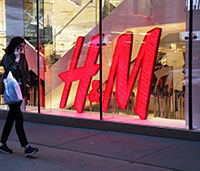 Fast fashion is increasingly becoming disposable fashion as consumers are discarding their clothes after only one use. In the UK alone, consumers throw away over 300,000 tons of clothing every year. And part of the problem is over-production of clothing that is never sold. A power plant in Sweden recently switched to H&M clothing instead of coal to generate energy. In 2017, the power plant incinerated 15 tons of H&M products. Contrast this with luxe brand Burberry which burned around $37 million in clothing sometime ago to avoid selling it at a discount.
Fast fashion is increasingly becoming disposable fashion as consumers are discarding their clothes after only one use. In the UK alone, consumers throw away over 300,000 tons of clothing every year. And part of the problem is over-production of clothing that is never sold. A power plant in Sweden recently switched to H&M clothing instead of coal to generate energy. In 2017, the power plant incinerated 15 tons of H&M products. Contrast this with luxe brand Burberry which burned around $37 million in clothing sometime ago to avoid selling it at a discount.
Use of organic fibers on the rise
Taking eco-friendly revolution to a new level, brands are using non GMO soy clothing, organic linen fiber, and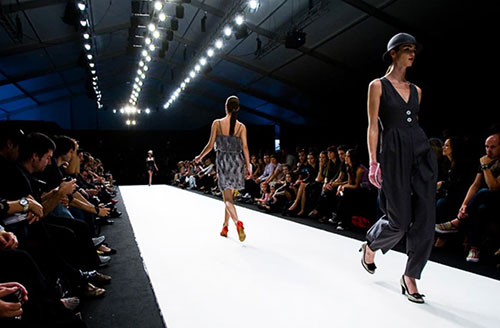 Lyocell fiber to make clothes. Rising demand for such clothes is also fuelling the rise of new startups. A recent example is Alternative Apparel acquired by major clothing maker Hanes in 2017. The label ensures sustainability through the use of organic cotton, recycled polyester and plastic bottles for the creation of eco-fabrics, non-toxic, gentle dyes and water-conserving washes. It also uses organic packaging, which saves 2,100 trees, 860,000 gallons of water, 120 tons of carbon dioxide and 400 cubic yards of landfill every year.
Lyocell fiber to make clothes. Rising demand for such clothes is also fuelling the rise of new startups. A recent example is Alternative Apparel acquired by major clothing maker Hanes in 2017. The label ensures sustainability through the use of organic cotton, recycled polyester and plastic bottles for the creation of eco-fabrics, non-toxic, gentle dyes and water-conserving washes. It also uses organic packaging, which saves 2,100 trees, 860,000 gallons of water, 120 tons of carbon dioxide and 400 cubic yards of landfill every year.
New apps for reinventing distribution
Along with manufacturing, distribution of clothes is also being reinvented with new modes emerging. For instance, Stitch Fix introduced a new data-driven app that enables consumers to buy clothes and keep them for about a week before returning them. Banking on American demand to remain fashionable with minimum waste, the startup is trying to create a sustainable niche for itself in the market. Besides its own, it is also pushing over 1,000 other brands and earned over $366 million in the first quarter of 2019.
With upcycling becoming the new buzzword, demand for digital second-hand stores with a twist is also increasing. A well-curated thrift store, thredUP sells everything from dresses and coats to handbags and other accessories on the simple premise of waste-not, want-not.
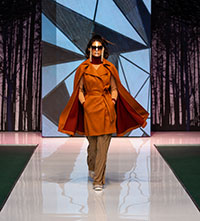 Festival of Fashion, Pure London ended after a successful three days of business and inspiration welcoming visitors from over 80 countries. Despite hurricane Ciara, buyers from stores including Selfridges, Debenhams, Next, Galeries Lafayette, Pamela Shiffer, Sunday Best, Asos, New Look, The Dressing Room, and Jules B flocked to Olympia for the AW20/21 presentation of over 1,300 inspirational and trend-led collections along with a three-day programme of insightful, challenging and stimulating content. While sourcing and manufacturing show Pure Origin attracted sourcing managers from brands including Prada, Burberry, Ann Summers, Gibbons, Next, Karen Millen, Maniere De Voir, Long Tall Sally, James Lakeland, Lipsy, Radley & Co, Monsoon, The Sourcing Team, YMC, Gloverall, Centro Sourcing, Amazon and TK Maxx.
Festival of Fashion, Pure London ended after a successful three days of business and inspiration welcoming visitors from over 80 countries. Despite hurricane Ciara, buyers from stores including Selfridges, Debenhams, Next, Galeries Lafayette, Pamela Shiffer, Sunday Best, Asos, New Look, The Dressing Room, and Jules B flocked to Olympia for the AW20/21 presentation of over 1,300 inspirational and trend-led collections along with a three-day programme of insightful, challenging and stimulating content. While sourcing and manufacturing show Pure Origin attracted sourcing managers from brands including Prada, Burberry, Ann Summers, Gibbons, Next, Karen Millen, Maniere De Voir, Long Tall Sally, James Lakeland, Lipsy, Radley & Co, Monsoon, The Sourcing Team, YMC, Gloverall, Centro Sourcing, Amazon and TK Maxx.
Martin Arnold, Fashion Portfolio Director of Hyve Group plc said: “Buyers really made the effort this season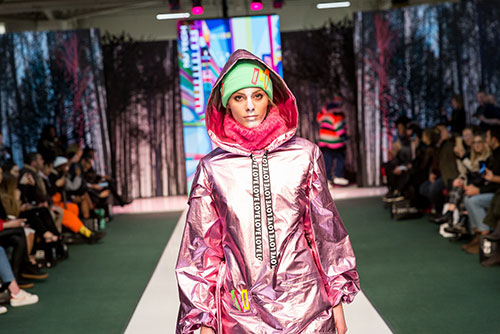 highlighting the importance and relevance that Pure London has in the buying calendar. Even with trains and flights cancelled due to the weather they showed the true grit of UK fashion to keep it business as usual, demonstrating the resilience of the market.” The show maintained a high level of visitors throughout the three days, with exhibitors commenting on the quality of the buyers and a continued interest in buying ahead for the new season.
highlighting the importance and relevance that Pure London has in the buying calendar. Even with trains and flights cancelled due to the weather they showed the true grit of UK fashion to keep it business as usual, demonstrating the resilience of the market.” The show maintained a high level of visitors throughout the three days, with exhibitors commenting on the quality of the buyers and a continued interest in buying ahead for the new season.
The AW20/21 catwalk shows and Unique Style Platform trend presentations were a big success, whilst talks on the Nomad and Origin Stages were delivered to packed audiences. Over 2500 people digested topics focused on sustainability, authenticity, visual merchandising, textile production and fabric life-cycles, garment marking, sourcing advice, industry standards, fashion-tech innovation, forecasting, inclusivity and empowerment, as well as a daily morning briefing outlining the unexpected benefits of Brexit and a workshop session on building business strategy to be Brexit resilient.
Trend partner Unique Style Platform outlined the macro trends for the AW20/21 season, highlighting a younger generational divide of Greta Thunberg vs Love Island groups – those fighting fast fashion opposed to those over-consuming it. Jane Kellock, Founder and Creative Director of USP said; “We are entering an era of extremes and conflict in society. AW20/21 is about finding balance.” The four key trends, Hibernate, Attune, Opulence and Nu-Tech were brought to life on the catwalk with a showcase of exhibiting brand collections. The next show takes place on the 19th – 21st July 2020 at Olympia London.
Yesterday, Wu Qing, vice mayor of Shanghai, together with a group of officials from the industry and public health departments in the city, toured Shanghai Challenge Textile Company Limited which is seated in Tinglin town in Jinshan District, outskirt in the southwest of Shanghai, for inspecting protective gear production to solve problems that might crop up at the time when the existing machines are running in full capacity and the new lines are put on stream because the populous metropolitan itself has to challenge the shortage of protective textiles with increasingly incoming workers who return after Chinese Lunar New Year holidays.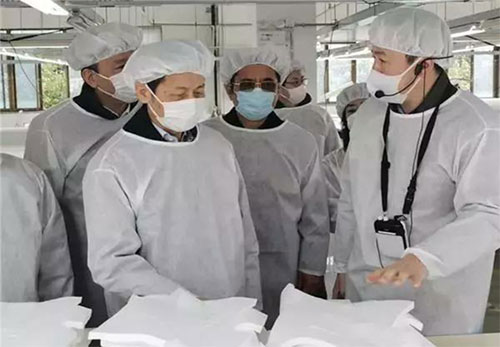
Robert Yang (1st on the right), ex-president of China Knitting Industry Association (2005-2015), incumbently, president of Shanghai Challenge Textile Co. Limited, reported that the company was called to produce protective garments on a short notice, and mobilized in a quick-responsive system to get the first batch of raw materials on February 3 to turn out 500 units of quarantine-purposed protective clothing the next day. The trial production was a success on daily account because the company has, for twenty years, been specialized in high-end fine wool fleece knit fabric and garment, including outdoor sports wear rather than this category of medical and health protective wear. As of February 9, the daily output is rated at 5000 units in capacity and expected to reach 10,000 in five days after remodeling the process flow and management improvement. Robert Yang pledged to expand the production capacity for the one-off isolation apparel to arrive at 20,000 units a day as driven by the pressing demand of the grave situation for the epidemic disease prevention and control and the actual needs from the government and the market.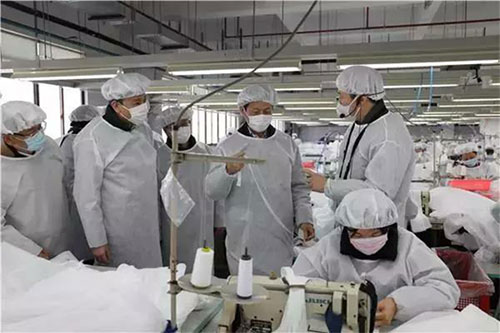
Robert Yang’s outlook to the market demand is right as the source from the Ministry of Industry and Information Technology (MIIT) shows that as of February 2, the whole country was accessible only to 20,000 units of medical and health protective wear in daily output, a marginal increase from that of January 28, still leaving much room to be fulfilled, far from cry, as thousands and thousands of doctors and nurses dispatched across the country to Wuhan, the coronavirus-ridden city, need to be well-equipped against any trace of possible contagion on the battle front, people from all walks of life from villages to cities in the country also need preventative measures to protect themselves against risk in daily life.
As a years-long business partner for famous international brands, such as Adidas, Uniqlo, Milliken, Polartec, Icebreaker, VF Corporation etc., Shanghai Challenge Textile Co. Limited is trustworthy of being a reliant, efficient, corporate-compliant quality supplier for medical-care protective wear and gear.
Contributed by Mr. ZHAO Hong
He is working for CHINA TEXTILE magazine as Editor-in-Chief in addition to being involved in a plethora of activities for the textile industry. He has worked for the Engineering Institute of Ministry of Textile Industry, and for China National Textile Council and continues to serve the industry in the capacity of Deputy Director of China Textile International Exchange Centre, V. President of China Knitting Industry Association, V. President of China Textile Magazine and its Editor-in-Chief for the English Version, Deputy Director of News Centre of China National Textile and Apparel Council (CNTAC), Deputy Director of International Trade Office, CNTAC, Deputy Director of China Textile Economic Research Centre. He was also elected once ACT Chair of Private Sector Consulting Committee of International Textile and Clothing Bureau (ITCB)
Coats, an industrial thread company that offers more than 20 products in ten sizes of thread has bought Pharr High Performance Yarns.
The acquisition of Pharr’s manufacturing capabilities and customer base will provide further expertise and scale to Coats’ existing personal protection business. Pharr wanted to find the right buyer and found it in Coats, a global leader with a long, proven track record, which understands Pharr along with its commitment to its associates and communities. Coats can enhance Pharr’s performance by leveraging its extensive textile experience, strong industry connections, existing operational footprint in North America, and strong brand to deliver high performance solutions for its customers. With Pharr, Coats hopes to acquire a deep expertise in technical yarn solutions and create ever lighter, stronger and more comfortable yarns for the most extreme environments. Coats and Pharr hope to collaborate by building on synergies to develop innovative products.
Coats supplies the market more than a hundred thousand colors in the market. It has launched many ranges of new innovative threads. One of these is the waterproof AS thread, which is used in footwear and down jackets. Pharr, based in the US, is a manufacturer of high-performance engineered yarns and specialises in providing technical yarn solutions to the industrial thermal protection, defense and fire service industries.
Bangladesh can become an example of a protective global supply chain, providing a model that can be adopted by countries around the world. It has been almost seven years since the Rana Plaza factory disaster, killing more than 1,100 workers, mostly young women, and injuring 2,500 others.
More broadly, there is a need for fresh approaches to address labor rights in Bangladesh and elsewhere. Buyers need to acknowledge how their own business models – which put a premium on lowest cost and fastest turnaround – often exacerbate pressures on local factory owners and harm workers. These global brands must also move away from the punitive policing model that currently places blame on local suppliers whenever factory auditors spot a problem. Instead, there is a need for a more collaborative model, one that emphasizes greater communications and cooperation between buyers and suppliers, and shares responsibility for the well-being of workers.
Bangladesh’s readymade garment industry is the second largest in the world and a major supplier to Europe. Since 2008, Bangladesh apparel exports have more than tripled, garment sector exports account for 82 per cent of all exports from the country. This tremendous growth has helped fuel the country’s economic development and cut the level of extreme poverty to half since 2000.
In Myanmar, the EU’s preferential trade tariffs have helped lift thousands out of poverty and reduce inequalities. Since 2015, Myanmar’s exports to the EU have grown by over 230 per cent. The EU’s enhanced engagement with Myanmar focuses more broadly on compliance with human rights conventions and labor rights. Partly thanks to GSP, countries like Myanmar are making constructive efforts to improve on labor rights, child rights and adherence to universal values. However, there are a number of areas where the EU will continue to encourage Myanmar to make urgent efforts, like democratic reforms, freedom of expression, cooperation with the UN and the rights of the Rohingya. The EU imports twice as much from least developed countries like Myanmar as the rest of the world does. Myanmar has shown a constructive attitude and engagement on the issues of concern raised by the EU.
The European Union will continue to engage with countries, including Myanmar, that fall under its Everything But Arms (EBA) trade initiative. EBA is an initiative under which all imports to the EU from least developed countries are duty-free and quota-free, with the exception of armaments. The initiative is part of the EU Generalised System of Preferences (GSP) aimed at encouraging development of the world’s poorest countries.
Fashion Source will be held in China from November 27 to 29, 2020. This is a leading textile and fashion trade shows in Asia and takes place twice a year organized by Premiere Vision. The upcoming event will bring together a creative range of materials – yarns, fabrics, accessories, leathers, textile designs – from a broad selection of Asian and European producers. Founded in 2001, Fashion Source brings together the entire Chinese fashion industry. The leading apparel sourcing trade fair in the South of China, welcomes in each editions (May and November) more than 1,500 exhibitors and 50,000 visitors from around 20 Asian, European and American countries. The location in the heart of Shenzhen has contributed to its rapid expansion, driven by the long history of the region’s textile and fashion industry, technological developments, and its proximity to Hong Kong and Canton.
China - looking beyond the current health situation - is expected to become the world’s largest market for clothing and luxury goods as of 2025. Première Vision’s intention is to help companies develop their activity in this major fashion market, which is rapidly growing more sophisticated and upscale, particularly in southern China, which is seeing an extremely rapid development of industry players.
In 2019, US jeans imports declined 3.16 per cent. The balance of power in denim manufacturing took a dramatic turn in 2019, leading to a decline in volume and value for the top three suppliers–China, Mexico and Bangladesh–and strong upswings for the next three–Vietnam, Pakistan and Egypt.
US denim imports from China plummeted 25.87 per cent in volume in 2019. The fall in value was 25.68 per cent. Mexico’s denim shipments to the US fell 1.84 per cent in value in 2019. The fall in volume was 6.78 per cent. Denim shipments from Bangladesh posted a 3.5 per cent increase in value in the year, but saw volumes fall 2.49 per cent. Jeans imports from Vietnam jumped 25.6 per cent in value in 2019. In volume, the country shipped 28.62 per cent more merchandise for the year. Denim imports from Pakistan rose 8.69 per cent in volume while increasing 5.13 per cent in value. Imports from Egypt rose 12.7 per cent in value and increased 8.96 per cent in volume. Denim imports from Nicaragua were up 16.91 per cent in value terms while volume was down 3.73 per cent. And denim imports from Cambodia increased 11.8 per cent in value as volume decreased 0.49 per cent in the year.
Eurovet has made changes for 2020 events. This will include all three continents where the show organiser is active. In the US, Curve until now held in Las Vegas will be moving further West, to Los Angeles. Eurovet has brought forward the dates of Unique by Mode City show, to link up with the Paris Fashion Week, and has also set up a parallel event called Culture Swim. In spring, Eurovet will be making changes to its Asian program with a new event, Interfilière Shenzhen.
This too has a strategic change involving a relocation, as the Interfilière supply chain event from Hong Kong to China. The move is part of a new partnership with the China Brands Innovation Design Week (CKIW) show, a major knitwear trade event set up in the spring, after a split between its organisers. The first edition of Interfilière Shenzhen is scheduled from April 9 to 11, 2020. At the next edition of Interfilière Shanghai, on September 24 to 25, 2020, Eurovet will in fact try a new format, opening the event to consumer brands and not just textile manufacturers. Initially, the focus will be on a selection of Chinese brands, picked by Eurovet to complete the industry picture.












